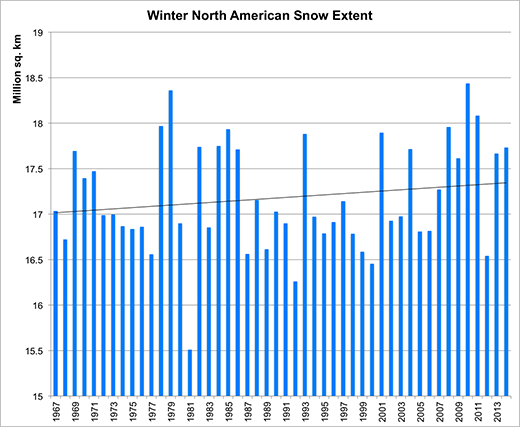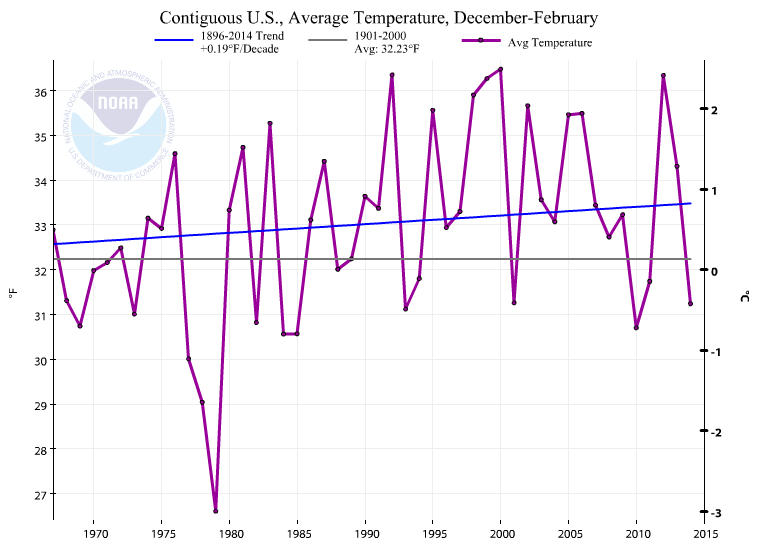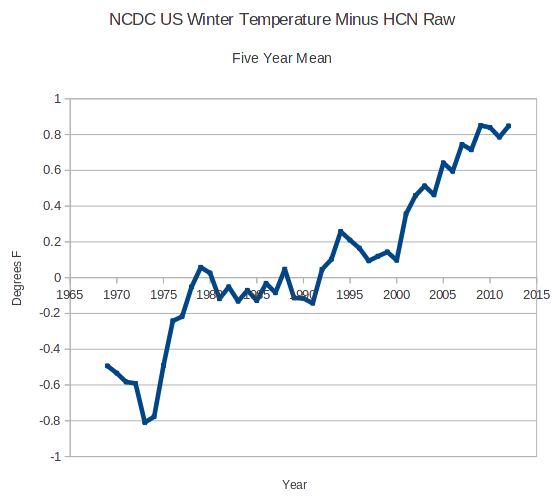Since 1967, North American winter snow extent has been increasing, with many recent years being in the top twenty. The only reasonable explanation for this is that cold Arctic air is pushing further south into the United States during winter, causing snow to fall and remain on the ground further south than it did 50 years ago. During warm winters, the snow line moves further north. During cold winters, the snow line moves further south – i.e. greater extent. Canada is always covered with snow during winter.
Adjusted NCDC US winter temperatures show that the US is getting warmer during winter since 1967, which is at odds with the snow data
NCDC adjusts recent US winter temperatures upwards by 1.6ºF relative to the early 1970s. As always, they cool the past and warm the present to create the appearance of non-existent warming.
This leaves only two realistic possibilities.
- The freezing point of water has changed since 1967
- US winters are getting colder, and the NCDC adjustments are complete garbage.






Warmer weather means more precipitation and in the winter that means snow. In my neck of the woods, 2013-14 aside, we have had some very mild winters. The last good cold snap prior to the blast this past year was in 1997.
Warmer weather most certainly does not mean a larger snow extent in winter. Quite the opposite.
During warm winters, the snow line moves further north. During cold winters, the snow line moves further south.
Warmer weather means more precipitation? Tell that to the Saudis – they’ll be glad to hear the desert is just an optical illusion – a “mirage”, if you will.
They would have plenty of precipitation if they had moisture in the air… they don’t. It’s a desert. Warmer weather means more evaporation, which increases precipitation. Basic climate science.
Warmer weather means the snow line moves north, and a smaller snow extent.
Lego,
You need to check your Meteorology. Although the SW United States for instance has dry deserts. SA is in a Hot and very Humid Desert, it doesn’t snow there because it’s not cold enough.
Antarctica is considered a desert, with only 200mm (8 inches) of precipitation each year and far less inland.
http://en.wikipedia.org/wiki/Antarctica
So, the hottest place on Earth, with no moisture in the air, is a desert and the coldest place on Earth, with the most frozen ice and snow, is a desert.
You say, “warmer weather means more evaporation, which increases precipitation”. Yes, and no. Mawsynram, in NE India is the wettest place on Earth, with annual rainfall of 467 inches. Hawaii’s Mount Waialeale has 450 inches p.a. Tutunendo, Colombia has 448 inches.
What’s the common denominator, you ask? They’re all on the Equator. Why are places on the Equator hotter and wetter than any other places on Earth?
Hint: it has nothing to do with CO2.
“Basic climate science.”
So in this version of “basic climate science” we would expect to see less snow as it gets colder.
Steve Case says:
July 3, 2014 at 10:45 am
Total and local are different things.
I’ll go with door #2.
All has to do with the AMO phases. More snow in winter with +AMO and less in Spring and Fall with +AMO.
Less Arctic sea ice with +AMO and more with -AMO.
Has nothing to do with your possibilities
really,so the air temperature and temperature of the ground where the snow is falling have nothing to do with it. i think i will disagree with that.
i understand what steve case is saying if he means regions that experience conditions that are typically too cold and dry for snow may experience more snow in warmer (relatively speaking) conditions,but even a moron like me can see the snow line, in every region where snow is seasonal, changes depending on how cold it is ,and how long that cold lasts.
Well, his first “possibility” was obviously facetious, which makes you a doofus.
His second possibility was that it’s getting colder and, if the AMO is in a positive phase, then the USA will be getting…colder! Which also makes you a doofus.
Congratulations. Only the truly imbecilic can be completely wrong, with absolute self-confidence.
So they finally discovered Ice 9 and have not told anyone.
Steve,
If you get time, it would be nice to see a follow-up on this post. In the follow-up you could show the Adjusted NCDC US winter temperatures verses the Unadjusted NCDC US winter temperatures. I am willing to bet that the unadjusted figures are much lower.
It would also be nice to see a raw temperature plot of just those stations that are real (not the zombies) and in rural areas rather than those surrounded by air-port asphalt.
Note: please tell me they don’t adjust the snowfall records too.
Yes. it is true that warmer winters can cause more snow. When it is below zero, there is very little snow. Most glaciers in the coldest regions grow slowly but steadily with only a few inches of snow a year.
You see, below zero snow is icier than 30 degree F snow, it is rock hard crystals whereas warmer snow is fluffy.
Fluffy snow can be deeper than icy snow and is much easier to shovel. Icy snow is like solid rock when it freezes up even more when it is say, -40 F. The air, when it is bitter cold, is very dry because it has frozen all the moisture which has dropped to the ground.
So…the depth of snow reflects more or less the amount of moisture which is higher in warmer winters than in very cold winters. It doesn’t determine how cold it is or even the snow extent further to the south.
Then there are winters with little snow and which are warmer than normal. These, too, happen. This is when it is warm enough for snow to turn into slush and then cold rain.
You talk about all of the factors that effect snow fall and I’m sure there are many of them. But, the old line: “Other things being equal” applies just like it does in economics. If you take a typical winter in the US. And just reduce the average temperature by 1F “Other things being equal” there will be more snow extent. May not be true if you reduced the temperature 30F or if it were an extremely unusual winter.
If you reduce the temperature 30F, you have the climate of northern Canada – which is always snow covered in winter.
“Yes. it is true that warmer winters can cause more snow.”
But why does the data show the opposite of this claim and a very strong correlation?
I.e.,
http://wattsupwiththat.files.wordpress.com/2013/02/ushcn_colorado_snow_vs_temp.jpg?w=640
What empirical data can you cite to support anything you’ve just written? Climate science seems to be permeated with so many semi-plausible sounding “just so” stories, I would like to confirm that there is some scientific basis to what you just wrote, and it’s not just another one of those urban climate myths that are so popular. Thanks.
If you have an increasing snow line, it means only one thing. The air temp is getting colder. Sure, one could use the argument warmer air temps bring more snow argument, but for the snow line to exist it needs another item, cold air to freeze and keep the ground frozen, otherwise the snow line would melt away quickly from ground heat. Snow can only remain on frozen ground. Snow depth contributes little, the main driver being air temps. Read here :https://www.ipcc.ch/pdf/assessment-report/ar4/wg1/ar4-wg1-chapter4.pdf, scroll down to section 4.7.3.2 – Seasonally Frozen Ground in Non-Permafrost Areas. Heller is correct, the snow line can be used as a proxy to estimate that if the snowline is extending further south, then air temps in these regions have to be colder.
Water still changes state at 0 C so if it is above freezing it is rain and below freezing it is snow. That is all that matters.
Nominal conditions, esp where a seed or other ‘disturbing’ conditions are present. Look up super cooled water for freezing at a depressed temperature (below 0 c or 32 F)
C’mawn man! This is easy. You CAGW-believing / deniers of natural climate change need to use your brain. Where does the snow line fall in the U.S.? (Hint: It ain’t at the poles). The snow line falls across the middle of the U.S., for example, Indiana (note my handle). In other words, the area of the U.S. were the average temperature hovers around freezing for much of the winter.
In warm winters, we get snow. It melts after a few days. It may even be true that we get more snow in warm winters, but it doesn’t matter, because there are enough warm days to melt ALL the snow after a few days.
In cold winters, we get snow. Maybe even less snow that in warm winters, but it doesn’t matter, because there are not enough warm days to melt ALL the snow.
The result? In cold winters the snow accumulates and the snow line/snow extent moves south.
“where” not “were” above.
There may be more snow, but it’s a warm snow.
Hahahahaha.
You laugh, but, we often get snow in the DFW area when air at the ‘surface’ (maybe 1000 ft thick air) is above freezing in 34 deg F area and snow is falling .. it may accumulate, too, as the air is cooled by the snow, and eventually grass is covered and yet later concrete and asphalt …
We are learning from this that USHCN only supports the notion of global warming if you assume that older thermometers ran hot and today’s thermometers run cold. Otherwise the warming does not appear in the original records; they have to be processed, like tree proxies. Not only is the heat hiding in the oceans, even thermometers are hiding some.
None of the usual suspects chimed in with the “but its thin, rotten snow” comment 😉
There is one other thing that happens in the NCDC vs HCN graph…the ‘coldest’ year becomes 1976. That means, the 1979 start date for the Arctic ice monitoring comes in a ‘not coldest’ year and by inference, must mean it’s NOT a maximum.
The snow line supports the 1979 date.
I wonder what the Canadian records would show for the same period?
Good proxy find.
By my count we now have:
1) Great Lakes ice (extent and last date)
2) Economic reports
3) Snow extent
4) 90/100 degree days
I wouldn’t count #2 since the government plays with those economic numbers so much that the economic numbers are just about as credible as the laughingstock-in-chief and his merry band of czars. i.e. Any government generated number is greatly suspect. (my opinion)
However, you are spot on with 1, 3 and 4.
I think it’s past time for NCDC to present their complete methodology and justification for all of their “adjustments” from all of the historical data. And “because we have PhD’s we say so” is not a valid justification for the adjustments to the temperature record.
Methinks the fine folks at NCDC are doing a wonderful imitation of a deer in the headlights. Thus they will take a month or so to attempt to craft some spin to justify their actions to date.
Plus all time highs at long term active stations. In my view this is very supportive ovre Goddard’s evidence.
Nice reality check, Steve.
Better keep an eye on those snow data …. y’know what I mean ? 😉